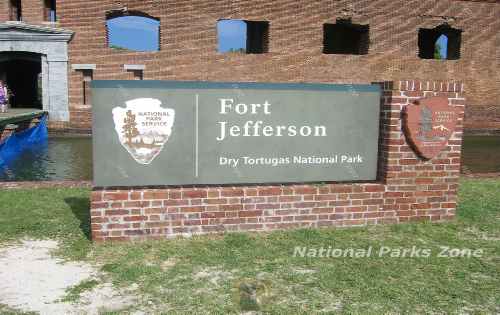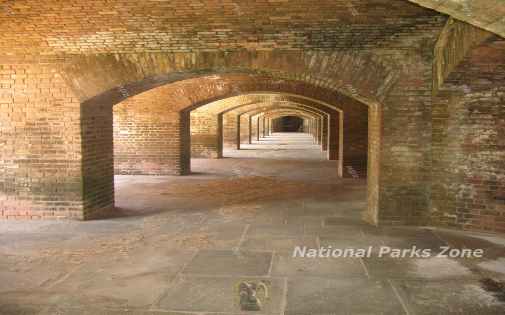Copyright © 2014-
All Rights Reserved

Updated 02/11/23 7:04 PM
Dry Tortugas National Park
Take a high speed catamaran 70 miles out to Fort Jefferson in the Gulf of Mexico. Explore one of the largest brick and stone structures ever built in the United States.
Florida
2010
About The Park
Far down on the list of visits to national parks is Dry Tortugas National Park. Created as a national park in 1992, it was formerly Fort Jefferson National Monument. It lies 70 miles west of Key West, Florida and is accessible only by boat or seaplane. Getting to it is not easy and explains why only 54,000 people visited it in 2017. The National Park Service has been keeping records since 1939 and the Dry Tortugas has totaled a little over 2 million visitors in 78 years. Parks like Zion and the Grand Canyon get 3 to 5 million visitors a year and the Great Smoky Mountains National Park over 9 million in a single year.
The park covers 100 square miles but less than 1% of it is dry land.
The boat trip from Key West, Florida is on a high-
The place originally got its name from the abundance of sea turtles in the area, Tortugas is Spanish for turtles, and supposedly the explorer Ponce De Leon gave it the name ‘Las Tortugas’. Eventually, due to the absence of drinkable water, on the maritime charts, it was labeled ‘Dry Tortugas’.
When you arrive at Fort Jefferson, on Garden Key, you see a massive stone fortress, surrounded by a moat, that fills the island. One can only imagine how many barge loads it took to bring 16 million bricks here, along with cement, stone and iron, and unloaded. The thick walls were designed to repel cannon fire from the warships of that time (circa 1846). The fort was defended by an array of 420 heavy guns the largest of which weighed 25 tons. Most of these guns were removed in 1900 and sold for scrap but a number of them remain, probably the largest and heaviest, and can be seen on the fort’s walls. Construction went on for 30 years and was never finished. The fort was abandoned in 1874.
While ships could easily avoid the fort’s cannon fire they could not avoid the warships moored in its harbor.
Upon entry to the fort the boat provides a short orientation and you then take your own self-
During the Civil War it served as a prison for deserters and more famously for holding men convicted in the assassination of President Abraham Lincoln.
One of those convicted was Dr. Samuel Mudd, who probably had no knowledge of the plot, but who had the misfortune to have known John Wilkes Booth and have had him knock on his door on the night of the assassination to attend to his broken leg. He was convicted nonetheless, escaping execution by a single vote, and sent to Fort Jefferson where he distinguished himself during the yellow fever epidemic and was ultimately pardoned in 1869. There is a plaque at the Fort that commemorates this.
People also go to this area to snorkel and scuba dive in the warm, crystal clear waters typical of the Gulf of Mexico. There is a camp ground on Garden Key and I suppose you could take the hydrofoil out one day and back on another day or the following week. The remote location makes for good stargazing. There is limited docking for private boats and none for overnight. They would have to be moored offshore overnight. There are several other keys (islands) in the area with various restrictions. Tours do not go to them. There are areas marked on the map as good scuba diving and some shipwrecks. These are not going to be seen on the typical one-
While, as a tourist it’s an interesting and picturesque place, but one can only imagine what a dreary existence it was for soldiers who had the misfortune to be stationed here.
Wildlife
The wildlife is all aquatic.
Lodging
There is no lodging in the park. Lodging can be found in Key West where excursions to Fort Jefferson can be arranged.
Hiking
There are no hiking trails on this very small island.
Dry Tortugas National Park Photo Gallery
Other Resources
Dry Tortugas National Park on the National Parks Service Website -
Dry Tortugas -
Seaplane Tours
Fort Jefferson Tours


Other National Parks Within a Day’s Drive
Biscayne National Park Here you can take a glass-
Everglades National Park Alligators, crocodiles and bald eagles populate Florida’s famous ‘river of grass’ is also about a 140 mile, 3-
*N*P*Z*
National Parks Zone